Introduction
Millets originated primarily in South-East Asia, Eurasia, and East & West Africa. They are widely variable, small seed plants belonging to the Eragrostideae, Paniceae, and Andropogoneae tribe of grasses of the Poaceae plant family. Apart from sorghum (Sorghum bicolor), pearl millet (Pennisetum glaucum) and finger millet (Eleusine coracana) are considered significant millet in India. India is the world’s largest millet producer, followed by Nigeria and China.1
On the nutritional value, they are generally considered nutritious cereal grains, rich in phytochemicals, especially polyphenols and trace elements.2,3 With the growing interest in gluten-free cereal diets among people with celiac metabolic defects, the demand for millet as a human food supplement has increased.4 The nutritional value of millets varies with variety and cultivation conditions. The presence of various anti-nutrients like tannins, phenolics, oxalates, phytates, proteases, and amylase inhibitors further inhibit the bioavailability of nutritious compounds. The condensed tannins in millet are typically associated with proteins and effects dietary protein digestibility, enzyme activity and bioavailability of minerals. Although most millets have high calcium and iron content, their binding with oxalates and phytates reduces their bioavailability.
Millets are utilised in the form of grounded flour as porridges, fermented and non-fermented bread, boiled products, snacks, and alcoholic and non-alcoholic beverages. Various previous works have reported that pre-treatment like dehulling and decortication, germination, fermentation and heat moisture treatment and other thermal processing could decrease the level of anti-nutritional factors and increase the bioavailability of nutritional elements.5,6,7 One should keep in mind that majorities of these operations are combined with other processes.
Dehulling is one of the most common practices in millet processing; as dehulling and decortication removes the tannin-rich outer layer of millet, the final product exhibits improved digestibility and reduced astringency with an overall decrease in anti-nutritional factors.8 But it also reduces fibre and polyphenolic content since they are also present primarily in the outer layer. Steeping is one of the predominant wet pre-treatment, generally used before the flour milling process and is also known as tempering or wet milling.9 Water diffusion during steeping creates an aqueous environment which solubilises and facilitates the leaching of the tannins, phytates and phenolic compounds.3 Similarly, during germination, tannins, phytates, and other phenolic compounds leach out on the surface because of the humid atmosphere and hydrated grains. It is not only phenolic compounds which migrate during the germination process; various enzymes like polyphenol oxidase (PPO), which utilise phenolic compounds, also get mobilised during the germination process. This movement affects the phenolic content, as the enzyme uses the phenolic compounds as a substrate in the grains and also increases the antioxidant activity.3
Fermentation and germination also affect the amylose content and the structure of amylopectin in sorghum. These treatments yielded more pores in the granule surface and changed the crystallinity of the flour. Changes in these structural properties will affect the gelatinisation temperature and application of the treated flour.10,11
Consequently, the present work’s objective was to examine the effect of the main wet-processing methods, namely steeping, fermentation, germination, and combination of germination with the fermentation of grains, on the physicochemical and functional attributes of the millet flour. The structural properties (particle size, X-ray diffraction pattern, and gelatinisation) and chemical properties (proximate, anti-nutrients, phenolic content, and antioxidant) were studied.
Materials and methods
Pearl millet (PC612) and finger millet (VL146) utilised for the current study were secured from the ICAR – Indian Agricultural Research Institute, Pusa, New Delhi. They were cleaned manually for the removal of foreign matter. Further, they were screened using a mechanical sieve to remove dust and other lighter particles. Cleaned grains were kept in sealed commercial polypropylene bags and stored at 4±1°C until further use.
Flour preparation
A clean, untreated grain sample was used for control. Steeping was performed by submerging grains in water treated with double distilled water (DD) in the ratio of 1:3 (w/v) for 16 hr at 28±1°C. After the steeping, water was drained, and grains were washed with fresh DD water and kept for drying.12 For natural fermentation, grains were submerged in DD water (w/v: 1:3) for 72 hr at 28±1°C, and water was not changed throughout the fermentation process. Once the process was over, water was drained, grains were washed with fresh DD water and were kept for drying.13 For germination, grains were steeped in DD water for 12 hr and then spread on a tray covered with wet muslin cloth for 3 days at 30°C for sprouting.10 Once sprouting was achieved, grains were placed in a hot air circulating tray drier at 55±2°C for 8 hr.14 After drying, rootlets were removed from the grains. A portion of these dried germinated grains was again fermented to prepare germinated fermented samples. All grains were put in a hot air circulating tray dryer at 55±2°C for 8 hr to achieve uniform moisture content (8±1% dry basis) before milling. Dried pearl millet and finger millet samples were milled using a rotating hammer mill at a feed rate of 6 kg/hr. The whole grain millet flour samples were kept in commercial polypropylene bags and stored at 4±1°C until further use. P1, P2, P3, P4 and P5; and F1, F2, F3, F4 and F5 represent untreated control, steeped, fermented, germinated, and germinated fermented flour samples for pearl millet and finger millet respectively.
Physical and Functional Properties
Particle size distribution
Particle size distribution of the millet flour samples was calculated using #16, 30, 60, 100 and 200 BSS standard sieves (1mm; 0.5mm; 0.25mm; 0.15mm; and 0.075mm respectively) and 50 g sample size.15 Results were reported as percentage retention on each sieve.
Density
The bulk density and the tapped density of the control and pre-treated flour samples were estimated by the method described by Mohite et al. and Adebiyi et al. respectively.16,17
Absorption capacity and solubility index
The absorption capacity of the flour sample was determined by measuring the gain in weight per gram after treatment with double distilled water and oil, respectively. For water absorption capacity (WAC), 1 g millet flour sample was vortex blended with 10 mL DD water in a pre-weighted centrifuge tube for 2 min. The tube was kept still for 30 min at 25°C, then centrifuged at 3000g for 30 min. The WAC was expressed as a gain in weight after removing the supernatant. For absorption capacity (OAC), 10 mL of sunflower oil was used instead of DD water.18 The correction was made for initial moisture content, and the result was calculated on a dry basis. The density of oil was determined (0.91 g/mL), while the density of water was assumed as 1 g/mL at 25°C.17
To determine water solubility index (WSI), 1 g of millet flour sample was mixed with 10 mL DD water and incubated at 25°C for 30 min; the tube was gradually agitated during this period. After incubation, the tube was centrifuged at 3000 g for 15 min, and the supernatant was decanted into an evaporating aluminium dish of known weight. WSI was calculated as the ratio of a dry solid present in the supernatant to dry sample weight.19
Gelation
The gelation was estimated using the method of S. K. Sathe, with slight modifications by using 5, 10, 15, 20, 25 and 30% (w/v) millet flour suspensions in 10 ml of distilled water. These water-flour suspensions were mixed thoroughly and then incubated for 1 hr in a boiling water bath. After incubation, test tubes were rapidly cooled under running cold tap water, followed by further cooling at 4°C for 2 hr. Completely cooled test tubes were inverted, and the least gelation concentration was noted.20
Hygroscopicity
The hygroscopicity of millet flour was determined by placing a known amount of flour samples into aluminium vials and equilibrating at around 75% relative humidity and 30±1°C in the humidity chamber. Samples were weighted until they reached equilibrium, and once it was achieved, the hygroscopicity was expressed as g moisture /100 g solids for equilibrium samples.21
Colour Analysis
Colour analysis of ground millet flour was performed using a handheld portable NS 810 Colour analyser (M/s Shenzhen 3nh Technology Pvt Ltd, China). The calibration of colour analyser was done using a pair of standard black and white plate, one after another. The lightness (L*), redness (a *) and yellowness (b*) values were obtained for each sample by filling the flour sample into provided standard 1-inch sample dish. Lightness value comes on the scale of 0 to 100, where 0 is for pure black, and 100 is for pure white. A positive value of redness indicates the red colour tint of the sample, while a negative value indicates a green tint in the sample. Similarly, a positive value of yellowness defines a yellowish tint in the sample colour, while a negative value defines colour departure towards a blue colour tint in the sample.22 Total colour change, which summarises absolute colour deviation from the control sample, is calculated using the following equation:23
Differential scanning calorimetry
The impact of wet processing on the thermal characteristics of the millet flour samples was examined using a Setaram DSC 131 Evo thermal analyser. Dry flour samples (2.0 – 3.0 mg) were loaded into hermetically sealed aluminium pans against an empty sealed pan as blank and then progressively heated from 20°C to 120°C at a rate of 10°C/min for the complete study.24
X-ray diffraction analysis
The crystalline property of millet flour samples was studied using X-ray powder diffraction analysis (Rigaku XRD Ultimate IV) with scanning region of the two (θ) angles varying from 5o to 65° at a speed of 2°/min for complete analysis.4
Chemical Properties
Proximate composition
Standard AOAC (2006) procedures were used to determine the proximate composition of the flour, including the crude fibre, crude fat, ash, crude protein and moisture content. Total carbohydrate was calculated by difference, and the Atwater factor was used to determine the total energy.25
Antinutritional factors
Tannin was extracted by the acidified methanol method, as explained by Onyango et al. The vanillin-hydrochloric acid reagent was mixed with the extract and incubated for 20 min before measuring the absorbance at 500 nm against a blank (vanillin-hydrochloric acid reagent). 1% acidified tannic acid is used as a standard solution at various dilutions from 1:10 to 1:50 for making a standard curve.26
For the estimation of phytates, the extract was prepared, as mentioned by Onyango et al. The extract was later mixed with acidic ammonium iron (III) sulphate dodecahydrate and boiled over a water bath for 30 min, followed by rapid cooling to 25°C. Further, 2′2′ bipyridine solution was mixed in the solution before taking the absorbance reading at 519 nm against DD water and phytate phosphorous as standard.26
Total phenolic content
The extract was prepared for determination of the total phenolic content (TPC), as mentioned by Pradeep et al. The acidic methanolic extract dilution was mixed with Folin–Ciocalteu reagent, followed by reaction neutralisation with the addition of 15% sodium carbonate. The developed blue colour absorbance was measured at 760 nm against the Gallic acid standard after 30 min. TPC of samples was stated as mg of gallic acid equivalent/100 g of the sample.27
Antioxidant properties
For determination of the antioxidant properties of millet flour samples, the aqueous flour extract was prepared by the process explained by Xu et al. The know concentration of the aqueous extract was used to estimate DPPH radical scavenging activity and hydroxyl radical scavenging activity by the method described by Du et al. and Xu et al., respectively. Ascorbic acid was used as the standard for the assay.28,29 Following formula was used for calculation of the percentage scavenging activity:
Where, A0 is the absorbance value of the control and A1 is the absorbance value of samples and ascorbic acid.
Statistical Analysis
All the measurements were done in triplicate, and results were stated as the means ± standard deviation of three separate determinations. Significant differences between mean values for each parameter were determined by Duncan’s multiple range tests carried out at a significance level of 0.05 using the statistical (SPSS 21, USA).
Results and Discussion
Physical properties of flour
Results of particle size distribution are represented in Figure 1 for all pre-treatments. The alteration in particle size distribution is directly related to the change in starch structure due to various pre-treatments. The prevailing aqueous environment during the wet treatment hydrolyses the starch, resulting in decreased average particle size upon milling. The smaller particle size also improves the nutrient digestion rate, as more surface area is available for enzyme reaction.15 In the case of pearl millet, germination, and germination-fermentation resulted in much more refined flour with a significant fraction of smaller particles with particle size less than 0.15 mm. For finger millet, all four pre-treatment resulted in a higher fraction of smaller particle size, though germination had more impact on it, a similar trend was also reported by Li et al.10
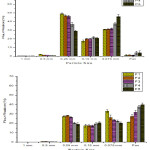 |
Figure 1: Particle size distribution of pearl millet and finger millet flour |
As indicated by particle size distribution, all pre-treatment results in a relatively high fraction of smaller particle size flour. Due to this, bulk density and tapped density decrease for each pre-treatment (Figure 2). Bulk density help in designing the application of flour as low bulk density flour is more suitable for weaning food preparation while high one is suitable for general food.30 Steeping has the least effect, while fermentation and germination have maximum impact on bulk density and tapped bulk density. For pearl millet flour, bulk density reduces by 6%, 11% and 15%, respectively, for fermentation, germination, and germination-fermentation. While for finger millet flour, germination and germination-fermentation reduce bulk density by 9% and 16%, respectively. Similar results have been reported in previous similar work. Pearl millet reported a 9% decrease during the same germination period.31
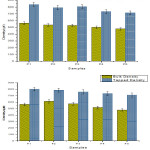 |
Figure 2: Bulk and tapped density of pearl millet and finger millet flour |
Functional properties of flour
Steeping and fermentation pre-treatment results in higher water absorption capacity for all three grains. Germination and germination-fermentation pre-treatment resulted in higher oil absorption capacity for both grains (Figure 3). For pearl millet, fermentation caused an 8% and 17% increase in water absorption, and oil absorption capacity, respectively and germination caused an 8% and 19% increase, respectively. In the case of finger millet, fermentation caused a 14% and 9% increase in water absorption and oil absorption capacity, respectively and germination-fermentation caused an 8% and 20% increase, respectively.
There is no significant change in the water solubility index for steeping and fermentation pre-treatment (Figure 4). But germination and germination-fermentation pre-treatment resulted in a significantly higher increase in water solubility index. For pearl millet flour, there was 83% and 151% increase due to germination and germination-fermentation, while for finger millet, there was a 177% and 281% increase. For pearl millet, no significant change in water absorption capacity has been reported, but in the case of germination, an increase of 6% has been reported.31
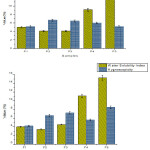 |
Figure 3: Water absorption capacity and Oil absorption capacity of pearl millet and finger millet flour. |
All pre-treatment results in relatively high hygroscopicity (Figure 4). For finger millet, all pre-treatment shows significantly high hygroscopicity. For pearl millet, steeped, fermented, and germinated flour samples show significantly higher hygroscopicity. For pearl millet, fermentation, and germination resulted in a 25% and 15% increase in hygroscopicity. While for finger millet, the increase has been 71% and 33% for fermentation, and germination respectively. Ocheme et al. reported a 5% decrease for steeped pearl millet flour while a 14% increase in hygroscopicity for germinated flour compared to control pearl millet flour.31
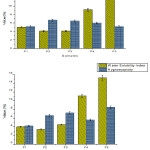 |
Figure 4: Water solubility index and hygroscopicity of pearl millet and finger millet flour. |
There is a significant difference in least gelation concentration between germinated, germinated fermented and other samples. Control, steeped and fermented samples exhibited a high level of a gel consistency with least gelation concentration of 20%, while germinated flour required 30% for gel formation for both millet flour samples. Further germinated-fermented flour samples failed in producing the gel. It may be due to the denaturation of protein induced by germination, as it accelerated the aggregation of protein.18 In the case of pearl millet 100% raise in the least gelation concentration has been reported for germinated flour.31
L, a, and b-values calculated for control and different pre-treatment are shown in Table 1(a) and 1(b). In pearl millet germination resulted in a significant increase in L* value from 77.66 for untreated pearl millet to 80.39 for germinated pearl millet flour. The slight loss in lightness in fermented pearl millet might be due to non-enzymatic browning that occurred during the drying of grains.9 Germination also resulted in a high positive change in a* value, b* value. In finger millet, all pre-treatments resulted in a slight better-improved L* value with 74.00 for untreated, 76.14 for fermented and 77.97 for germinated finger millet flour. There has been a minor decline in the a-value or redness of the flour. These changes could be due to a loss in tannins during different pre-treatments. During steeping and fermentation, the a-value and b-value also decreased significantly from 1.64 to 1.01 and 1.03; and 14.13 to 12.23 and 12.17, respectively. This resulted in overall colour improvement of the flour in case of steeping and fermentation.
Table 1(a): Colour properties (L* a* b* coordinates) and total colour difference of pearl millet flour.
| Samples | L* | a* | b* | ΔE |
| P1 | 77.66±0.29c | 0.77±0.13a | 10.57±0.45a | 0.00a |
| P2 | 75.39±0.40b | 0.77±0.03a | 10.34±0.30a | 2.31±0.34b |
| P3 | 73.08±0.58a | 0.71±0.01a | 10.12±0.10a | 4.63±0.82c |
| P4 | 80.40±0.33d | 2.11±0.17c | 13.58±0.50c | 4.32±0.50c |
| P5 | 80.12±0.11d | 1.63±0.06b | 11.43±0.35b | 2.80±0.08b |
Means followed by the same letter in a column do not differ significantly from one another (P > 0.05).
Table 1(b): Colour properties (L* a* b* coordinates) and total colour difference of finger millet flour.
| Samples | L* | a* | b* | ΔE |
| F1 | 74.00±1.16a | 3.76±0.06a | 7.87±0.84a | 0.00a |
| F2 | 76.86±1.15b | 3.16±0.06a | 6.89±0.54a | 3.08±0.11bc |
| F3 | 76.14±2.15ab | 3.20±0.19a | 6.79±0.29a | 2.46±0.12b |
| F4 | 77.98±0.49b | 3.43±0.98a | 8.67±0.31a | 4.53±0.47d |
| F5 | 77.25±1.95b | 3.01±0.02a | 6.37±0.37a | 3.66±0.44cd |
Means followed by the same letter in a column do not differ significantly from one another (P > 0.05).
The X-ray diffraction pattern and crystallinity of native and pre-treated flours exhibited an A-type polymorphic form (Figure 5), which has been similar to other cereal flour with no significant difference in the pattern.10,17 This may be due to no substantial change in the crystalline structure of flour starch during wet processing. Raw pearl millet flour exhibited 4 high-intensity peaks at 15.10, 17.10, 22.92 and 47.9 2θ°, with the highest at 17.10 2θ°. Steeped and fermented pearl millet flour shows 2 peaks each at 17.68 and 23.18; and 17.63 and 23.18; respectively. While germinated and germinated-fermented flour samples showed three intensity peaks at 15.180, 17.96, and 23.42; and 15.140, 17.21 and 23.04, respectively. Finger millet flour showed peaks at 15.04, 17.84, 23.38 and 47.36 2θ°, respectively. Steeped finger millet has three peaks at 18.04, 23.32 and 33.9 2θ°, respectively; fermented finger millet flour gave the peak at five different positions at 15.08, 17.81, 23.38, 34.10, and 47.01 2θ° respectively. Germinated and germinated-fermented flour gave three and five peaks, respectively (14.971, 17.85 and 23.18; and 15.03, 17.57, 19.94, 22.83 and 47.2 2θ°, respectively). All pre-treatment resulted in a significant decrease in onset, offset and peak temperature for pearl millet and finger millet (Figure 6). Due to partial solubilisation of starch, germinated and germinated-fermented samples exhibited a maximum decrease in the case of pearl millet. In contrast, for finger millet, the steeped sample has a minimum value. The peak temperature decreased from around 3°C to 8°C for different pre-treatment for pearl millet and finger millet. For finger millet, germinated flour showed the highest enthalpy change, it may be attributed to an increase in crystallinity.10 While in the case of pearl millet, it showed the lowest enthalpy change.
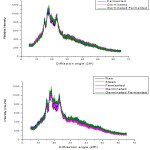 |
Figure 5: X-ray diffraction patterns of pearl millet and finger millet flour |
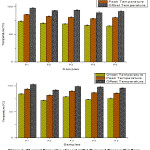 |
Figure 6: Thermal Properties of pearl millet flour and finger millet flour |
Chemical Properties
The proximate composition (percentage dry basis) of controlled and treated flour samples is given in Table 2(a) and 2(b). There has been a significant increase by 5%, 25% and 38% in crude protein content during steeping, fermentation, and germination, respectively. For finger millet, there has been not much significant change in protein content, with an increase of 2.5% and 7% during fermentation and germination. This increase could be credited to the increase in protein solubility due to wet pre-treatments.32 During germination, a 28% increase in protein content has been reported for finger millets and a 22% increase in pearl millet.31,33 For fat content, there has been a slight increase of 8% and 1% in pearl millet and finger millet, respectively, during fermentation. For the all-grain samples, fat content reduced by 7% to 11% during germination. Fat content also reduced as fat is utilised for fulfilling energy requirements during germination.34 With a 5% to 6% decrease, crude fibre content decreased significantly during fermentation. At the same time, it increased considerably during germination, 21% and 22%, respectively, for pearl millet and finger millet. As reported in previous work, during germination, new cell wall structure development might increase the amount of crude fibre slightly.35 After germination, a 5% increase in crude fibre has been reported in pearl millet flour.31 Also, a slight decrease in fibre content was reported, possibly due to the enzymatic solubilisation of fibre during fermentation. Ash content reduced significantly for all pre-treatments with 5% and 25% reduction during fermentation and 7% and 35% reduction during germination for pearl millet and finger millet, respectively. There has been a report of a slight decrease in ash content during germination of millet which may be attributed to the utilisation of minerals at the start of sprouting.36
Table 2(a): Proximate composition of pearl millet flour (% dry basis)
| Samples | Protein | Fat | Ash | Crude Fibre | Carbohydrate |
| P1 | 9.43±0.10a | 4.50±0.12b | 1.32±0.05d | 2.17±0.04b | 82.59±0.76c |
| P2 | 9.93±0.10b | 4.98±0.04d | 1.37±0.05e | 2.16±0.05b | 81.56±0.87c |
| P3 | 11.84±0.12c | 4.86±0.09c | 1.26±0.04c | 2.03±0.04a | 80.02±0.76b |
| P4 | 13.06±0.13d | 4.21±0.07a | 1.23±0.05b | 2.63±0.07d | 78.88±0.86ab |
| P5 | 13.30±0.12e | 5.05±0.12d | 1.15±0.04a | 2.52±0.03c | 77.98±0.53a |
Means followed by the same letter in a column do not differ significantly from one another (P > 0.05).
Table 2(b): Proximate composition of finger millet flour (% dry basis)
| Samples | Protein | Fat | Ash | Crude Fibre | Carbohydrate |
| F1 | 8.46±0.09a | 2.76±0.04d | 2.22±0.03e | 1.67±0.03b | 84.89±0.68a |
| F2 | 8.50±0.09a | 2.59±0.03b | 1.99±0.04d | 1.80±0.04c | 85.11±0.64a |
| F3 | 8.66±0.08b | 2.80±0.06d | 1.67±0.04c | 1.59±0.04a | 85.28±0.84a |
| F4 | 9.07±0.10c | 2.52±0.04a | 1.44±0.05b | 2.03±0.06e | 84.94±0.92a |
| F5 | 9.09±0.10c | 2.65±0.08c | 0.94±0.03a | 1.84±0.04d | 85.48±0.68a |
Means followed by the same letter in a column do not differ significantly from one another (P > 0.05).
Bioactive Properties
Pre-treatment for both millet samples resulted in a significant reduction in phytic acid content and tannin content compared to the control sample (Figure 7). The phytic acid reduced by 42% and 24% during steeping, 54% and 34% during fermentation, and 70% and 75%, during germination, for pearl millet and finger millet respectively. For pearl millet, tannin reduced by 20% and 38%, and for finger millet, by 13% and 37%, respectively, during fermentation and germination. Tiwari et al. (2014) stated a significant decline in the phytic acid content of pearl millet seed with an increase in fermentation time. In previous work, 8.92% and 45.32% reductions in phytic acid content during steeping and fermentation have been reported.35,9 Apart from leaching, this reduction could be due to better phytase activity at lower pH as pH goes down during fermentation. Mahajan et al. also stated a similar results where endogenous phytase causes a reduction of phytate content in pearl millet during natural fermentation.37 In other work, 44.18% to 52.84% reduction in phytic acid content during germinating has been reported for pearl millet.38,39 In another similar work, a 34.21% reduction in tannins has been reported due to the sprouting of pearl millet.35 For finger millet, up to 55.8% reduction in phytic acid content during fermentation and up to 80.12% reduction during germination has been reported. In comparison, tannin reduced around 13.2% and 35%, respectively, during fermentation and germination.40 The collective effect of germination and fermentation resulted in a reduction up to 88.8% and 90.1%, respectively, for phytic acid and tannins, has been reported with a decrease of 44 to 52% in tannins during the fermentation of finger millet flour.41
Change in total phenolic content due to steeping, germination and fermentation are inconsistent in pearl millet and finger millet. For pearl millet, total phenolic content decreased significantly during steeping (14%) and further during fermentation (43%). Germination resulted in a total 57% reduction in total phenolic content. Similar results have been reported with a decrease up to 15% and 21%, in polyphenol content during steeping and fermentation respectively.35,9 While in another work, polyphenol content reduced by 40.88% to 46.54% during germination of pearl millet.38,39 This reduction might be attributed to the activity of polyphenol oxidase, which got activated during fermentation and germination, and due to the leaching of phytate ions during fermentation and germination due to a simple concentration gradient.35 For finger millet, germination reduced the total phenolic content significantly with a 36% reduction but remaining all pre-treatments did not show much effect on the total phenolic content. A 26 to 29% decrease has been reported during the natural fermentation of finger millet flour.41 In another work, a 19 to 21% decrease in phenolic content has been reported during steeping and germination, respectively 42. At the same time, Chethan et al. reported a 40% reduction in polyphenols during 72 hr of germination in finger millet.43
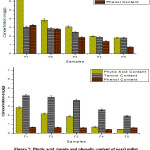 |
Figure 7: Phytic acid, tannin and phenolic content of pearl millet and finger millet flour |
Antioxidant properties of flour were mentioned in terms of EC50 values, which define the minimum effective concentration to achieve 50% free radical scavenging activity (Figure 8). For all samples, steeped flour samples exhibited better DPPH free radical scavenging activity than untreated flour samples. For pearl millet, steeping and germination resulted in better DPPH scavenging activity with the maximum for germinated flour followed by steeped flour. While for finger millet, both steeped flour and germinated flour display better DPPH scavenging activity compared to the untreated sample with the same activity level. For pearl millet, all pre-treatments resulted in decreased radical scavenging activity of hydroxyl radical, although fermented pearl millet flour expressed maximum scavenging activity among all pre-treatments. For finger millet, steeping demonstrated maximum scavenging activity of hydroxyl radical. Rest all pre-treatments resulted in decreased antioxidant activity for finger millet. The total phenolic content reduction during prolong hydration could be attributed to decrease in antioxidant activity after fermentation.27
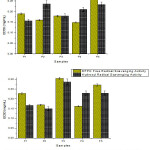 |
Figure 8: Antioxidant/ Free radical scavenging activities of pearl millet and finger millet flour |
Conclusion
Due to hydration of starch and activation of enzymes, all the wet pre-treatments affect the macro structure of the flour samples. The impact is more severe during germination and germination-fermentation compared to steeping and fermentation as visible in reduction of average particle size of flour. Due to a decrease in average particle size, pre-treatments also resulted in reduced density. While steeping and fermentation, both pre-treatments improved water absorption capacity, and gel consistency of the flour, germination and germination-fermentation resulted in improved oil absorption capacity, water solubility index and hygroscopicity. Gelatinisation peak temperature was also reduced due to different pre-treatments. For finger millet, germination caused the increase in enthalpy change of gelatinisation. The prevailing aqueous environment during wet pre-treatment not only mobilised various enzymes but also assisted in leaching of anti-nutritional factors like tannins and phytates. Due to the reduction in tannin, all pre-treatment also improved the flour’s colour. Germination and germination-fermentation were found to reduce total phenolic content significantly, and so antioxidant capacity. Although antioxidant properties of the flour were found to be improved significantly due to steeping. All pre-treatments improve the flour’s protein content. Germination caused a significant reduction in fat and ash content, while it improved the fibre content of the flour.
Acknowledgment
We are appreciative to everyone who has offered support during the work and helped us in completion.
Conflicts of Interest
All authors mentioned no conflicts of interest in this research.
Funding Sources
No financial assistance was provided for the research.
References
- Meena RP, Joshi D, Bisht JK, Kant L. Global Scenario of Millets Cultivation. In: Millets and Millet Technology. Springer Singapore; 2021:33-50. doi:10.1007/978-981-16-0676-2_2/COVER
CrossRef - Chandrasekara A, Shahidi F. Content of insoluble bound phenolics in millets and their contribution to antioxidant capacity. J Agric Food Chem. 2010;58(11):6706-6714. doi:10.1021/jf100868b
CrossRef - Shahidi F, Chandrasekara A. Millet grain phenolics and their role in disease risk reduction and health promotion: A review. J Funct Foods. 2013;5(2):570-581. doi:10.1016/j.jff.2013.02.004
CrossRef - Amadou I, Elhadji M, Shi Y, et al. Fermentation and heat-moisture treatment induced changes on the physicochemical properties of foxtail millet (Setaria italica) flour. Food Bioprod Process. 2014;92(1):38-45. doi:10.1016/j.fbp.2013.07.009
CrossRef - Taylor JRN, Duodu KG. Effects of processing sorghum and millets on their phenolic phytochemicals and the implications of this to the health-enhancing properties of sorghum and millet food and beverage products. J Sci Food Agric. 2015;95(2):225-237. doi:10.1002/jsfa.6713
CrossRef - Gupta V, Nagar R. Effect of cooking, fermentation, dehulling and utensils on antioxidants present in pearl millet rabadi – A traditional fermented food. J Food Sci Technol. 2010;47(February):73-76. doi:10.1007/s13197-010-0018-0
CrossRef - Chauhan ES, Sarita. Effects of processing (Germination and popping) on the nutritional and anti-nutritional properties of finger millet (eleusine coracana). Curr Res Nutr Food Sci. 2018;6(2):566-572. doi:10.12944/CRNFSJ.6.2.30
CrossRef - Awika JM, McDonough CM, Rooney LW. Decorticating sorghum to concentrate healthy phytochemicals. J Agric Food Chem. 2005;53(16):6230-6234. doi:10.1021/jf0510384
CrossRef - Tiwari A, Jha SKK, Pal RKK, Sethi S, Krishan L. Effect of pre-milling treatments on storage stability of pearl millet flour. J Food Process Preserv. 2014;38(3):1215-1223. doi:10.1111/jfpp.12082
CrossRef - Li C, Oh SG, Lee DH, Baik HW, Chung HJ. Effect of germination on the structures and physicochemical properties of starches from brown rice, oat, sorghum, and millet. Int J Biol Macromol. 2017;105:931-939. doi:10.1016/j.ijbiomac.2017.07.123
CrossRef - Olamiti G, Takalani TK, Beswa D, Jideani AIO. Effect of malting and fermentation on colour, thermal properties, functional groups and crystallinity level of flours from pearl millet (Pennisetum glaucum) and sorghum (Sorghum bicolor). Heliyon. 2020;6(12). doi:10.1016/J.HELIYON.2020.E05467
CrossRef - Pradeep PMM, Sreerama YN. Impact of processing on the phenolic profiles of small millets: Evaluation of their antioxidant and enzyme inhibitory properties associated with hyperglycemia. Food Chem. 2015;169:455-463. doi:10.1016/j.foodchem.2014.08.010
CrossRef - Akinola SA, Badejo AA, Osundahunsi OF, Edema MO. Effect of preprocessing techniques on pearl millet flour and changes in technological properties. Int J Food Sci Technol. 2017;52(4):992-999. doi:10.1111/ijfs.13363
CrossRef - Subastri A, Ramamurthy C, Suyavaran A, et al. Nutrient profile of porridge made from Eleusine coracana (L.) grains: effect of germination and fermentation. J Food Sci Technol. 2015;52(9):6024-6030. doi:10.1007/s13197-015-1713-7
CrossRef - Moraes ÉA, Marineli RDS, Lenquiste SA, et al. Sorghum flour fractions: Correlations among polysaccharides, phenolic compounds, antioxidant activity and glycemic index. Food Chem. 2015;180:116-123. doi:10.1016/j.foodchem.2015.02.023
CrossRef - Mohite AM, Mishra A, Sharma N. Effect of Different Grinding Processes on Powder Characteristics of Tamarind Seeds. Agric Res. 2020;9(2):262-269. doi:10.1007/s40003-019-00431-9
CrossRef - Adebiyi JA, Obadina AO, Mulaba-Bafubiandi AF, Adebo OA, Kayitesi E. Effect of fermentation and malting on the microstructure and selected physicochemical properties of pearl millet (Pennisetum glaucum) flour and biscuit. J Cereal Sci. 2016;70:132-139. doi:10.1016/j.jcs.2016.05.026
CrossRef - Elkhalifa AEO, Bernhardt R. Influence of grain germination on functional properties of sorghum flour. Food Chem. 2010;121(2):387-392. doi:10.1016/j.foodchem.2009.12.041
CrossRef - Balasubramanian S, Kaur J, Singh D. Optimization of weaning mix based on malted and extruded pearl millet and barley. J Food Sci Technol. 2014;51(4):682-690. doi:10.1007/s13197-011-0579-6
CrossRef - Devisetti R, Yadahally SN, Bhattacharya S. Nutrients and antinutrients in foxtail and proso millet milled fractions: Evaluation of their flour functionality. LWT – Food Sci Technol. 2014;59(2P1):889-895. doi:10.1016/j.lwt.2014.07.003
CrossRef - Ocheme OB, Oludamilola OO, Gladys ME. Effect of Lime Soaking and Cooking ( Nixtamalization ) on the Proximate , Functional and Some Anti-nutritional Properties of Millet Flour. AU J Technol. 2010;14(2):131-138.
- Krishnan R, Dharmaraj U, Sai Manohar R, Malleshi NG. Quality characteristics of biscuits prepared from finger millet seed coat based composite flour. Food Chem. 2011;129(2):499-506. doi:10.1016/j.foodchem.2011.04.107
CrossRef - Balasubramanian S, Singh KK, Patil RT, Onkar KK. Quality evaluation of millet-soy blended extrudates formulated through linear programming. J Food Sci Technol. 2012;49(4):450-458. doi:10.1007/s13197-011-0297-0
CrossRef - Rathore S, Singh K. A critical optimization study on hydrothermal treatment for decortication of pearl millet to improve its consumption efficiency. J Food Meas Charact. 2017;11(3):1501-1515. doi:10.1007/s11694-017-9529-y
CrossRef - AOAC. No Title. 18th ed. AOAC; 2006.
- Onyango C, Noetzold H, Ziems A, Hofmann T, Bley T, Henle T. Digestibility and antinutrient properties of acidified and extruded maize-finger millet blend in the production of uji. LWT – Food Sci Technol. 2005;38(7):697-707. doi:10.1016/j.lwt.2004.09.010
CrossRef - Pradeep SR, Guha M. Effect of processing methods on the nutraceutical and antioxidant properties of little millet (Panicum sumatrense) extracts. Food Chem. 2011;126(4):1643-1647. doi:10.1016/j.foodchem.2010.12.047
CrossRef - Xu J, Liu W, Yao W, Pang X, Yin D, Gao X. Carboxymethylation of a polysaccharide extracted from Ganoderma lucidum enhances its antioxidant activities in vitro. Carbohydr Polym. 2009;78(2):227-234. doi:10.1016/j.carbpol.2009.03.028
CrossRef - Du XJ, Mu HM, Zhou S, Zhang Y, Zhu XL. Chemical analysis and antioxidant activity of polysaccharides extracted from Inonotus obliquus sclerotia. Int J Biol Macromol. 2013;62:691-696. doi:10.1016/j.ijbiomac.2013.10.016
CrossRef - Ramashia SE, Gwata ET, Meddows-Taylor S, Anyasi TA, Jideani AIO. Some physical and functional properties of finger millet (Eleusine coracana) obtained in sub-Saharan Africa. Food Res Int. 2018;104(September):110-118. doi:10.1016/j.foodres.2017.09.065
CrossRef - Ocheme OB, Chinma CE. Effects of Soaking and Germination on Some Physicochemical Properties of Millet Flour for Porridge Production. J Food Technol. 2008;6(5):185-188. http://docsdrive.com/pdfs/medwelljournals/jftech/2008/185-188.pdf
- Afify AEMMR, El-Beltagi HS, El-Salam SMA, Omran AA. Effect of soaking, cooking, germination and fermentation processing on proximate analysis and mineral content of three white sorghum varieties (Sorghum bicolor L. moench). Not Bot Horti Agrobot Cluj-Napoca. 2012;40(2):92-98. doi:10.15835/nbha4027930
CrossRef - Swami SB, Thakor NJ, Gurav HS. Effect of soaking and malting on finger millet (EleusineCoracana) grain. 2013;15(1):194-200.
- Elmaki HB, Babiker E., El Tinay AH. Changes in chemical composition, grain malting, starch and tannin contents and protein digestibility during germination of sorghum cultivars. Food Chem. 1999;64(3):331-336. doi:10.1016/S0308-8146(98)00118-6
CrossRef - Nithya KS, Ramachandramurty B, Krishnamoorthy V V. Effect of processing methods on nutritional and anti-nutritional qualities of hybrid (COHCU-8) and traditional (C07) pearl millet varities of India. J Biol Sci. 2007;7(4):643-647. doi:10.3923/jbs.2007.643.647
CrossRef - Obizoba IC, Atii J V. Effect of soaking , sprouting , fermentation and cooking on nutrient composition and some anti-nutritional factors of sorghum ( Guinesia ) seeds Laboratory Analysis. Plant Foods Hum Nutr. 1991;41(3):203-212. doi:10.1007/BF02196388
CrossRef - Mahajan S, Chauhan BM. Phytic Acid and Extractable Phosphorus of Pearl Millet Flour as Affected by Natural Lactic Acid Fermentation. Published online 1987:381-386.
CrossRef - Archana, SEHGAL S, KAWATRA A. Reduction of polyphenol and phytic acid content of pearl millet grains by malting and blanching. Plant Foods Hum Nutr. 1998;53(2):93-98. doi:10.1023/A:1008060604880
CrossRef - Kapoor AC. Levels of antinutritional factors in pearl millet as affected by processing treatments and various types of fermentation. Plant Foods Hum Nutr. 1996;49:241-252.
CrossRef - Venkateswaran V, Vijayalakshmi G. Value addition to finger millet (Eleusine coracana) by germination and fermentation with Monascus purpureus. Int J Food Sci Nutr. 2010;61(7):722-727. doi:10.3109/09637481003757878
CrossRef - Antony U, Chandra TS. Antinutrient Reduction and Enhancement in Protein, Starch, and Mineral Availability in Fermented Flour of Finger Millet (Eleusine coracana). J Agric Food Chem. 1998;46(7):2578-2582. doi:10.1021/JF9706639
CrossRef - Towo EE, Svanberg U, Ndossi GD. Effect of grain pre-treatment on different extractable phenolic groups in cereals and legumes commonly consumed in Tanzania. J Sci Food Agric. 2003;83(9):980-986. doi:10.1002/jsfa.1435
CrossRef - Chethan S, Sreerama YN, Malleshi NG. Mode of inhibition of finger millet malt amylases by the millet phenolics. Food Chem. 2008;111(1):187-191. doi:10.1016/j.foodchem.2008.03.063
CrossRef

This work is licensed under a Creative Commons Attribution 4.0 International License.







